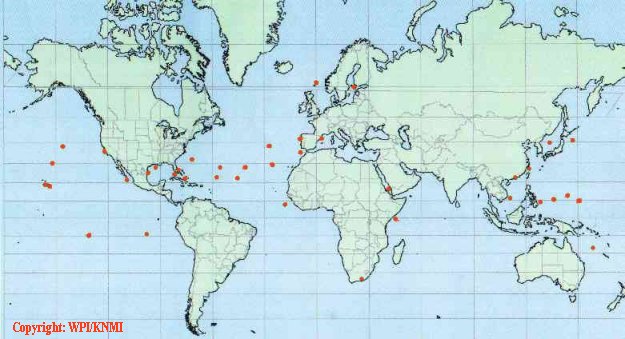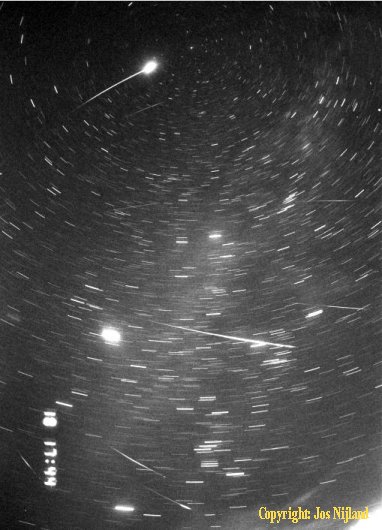| Impressive Leonidshow over the oceans of the world High quality
For me personally it was a nice surprise to see that officer
Armee now contributed to the meteor-project while I have met him several times during the
5-week periods aboard the former weathership Cumulus, at the Ocean Weather Station
positions Mike (66N 02E) and Lima (57N 20W). Willem, you and all the other sailors, thanks a lot
for the very important contribution to this special Leonid-observing project. |
|
| Meteor-observations received at: | Callsign/name vessel |
| 18 Nov | JGQH/Ryofu Maru, JDWX/Kofu Maru, PFJI/Kielgracht, PGFE, V7CB7/Iver Explorer, PGRE, PHHB, PFCZ, PCGR, PDHW, PFDI, PFDH/Nedlloyd Houtman, PCQL/Ankergracht, V7CZ8, C6QD2/Maracas Bay, JSVY/Shirase. |
| 20-11 | PGWY, PCBI. |
| 17/18-11 | GKFY/Baltic Eider. |
| 17-11, 18-11 | ELLG3, PEDS, PJKM. |
| 17-11, 20-11 | PDAH |
| 18-11, 19-11 | Seifu Maru, PDXQ, PGRQ/Pelagia, PJKX/Jumbo Challenger |
| 19-11, 20-11 | PGEB. |
| 16-11, 17-11, 18-11 | PBBU, JPBN/Keifu Maru |
| 17-11, 18-11, 19-11 | PFPQ/Looiersgracht , PCTG/Archangelgracht, PDWG. |
| 17/18-11, 19-11, 20-11 | ZQHM2. |
| 18-11, 19-11, 20-11 | PCBV. |
| 17-11, 18-11, 19-11, 20-11 | PDYI/Elandsgracht, PEAJ/Iver Example, PDZS, PEXU/Iver Pride, PCSS/Indonesia. |
| Also for the next Leonid-dust passage, mid-november 2002,
the expectations to a new show are high. Again we seem to pass through a thick dustcloud,
probably the last one in the next 99 years (except a smaller one in 2006). Detailed analysis of the actual observations could probably contribute to a better forecast of the 2002 crossing. We keep you informed. Finally I ‘d like to thank PMO-officer Jan Schaap, and his foreign colleagues, for their enormous support to make this unique project such a success. It gave us also a nice opportunity to inform the common public in a very special way about the never stopping voluntary data-stream from thousands of sailors on the Worlds oceans. Many papers in the Netherlands already have published about the oncoming project last November in their editions. Jacob Kuiper Co-ordinator Marine Leonid-observing campaign 2001 (e-mail: kuiper@knmi.nl) At he map you find the ‘raw’ vesselpositions from which we received Leonid-observations during the period Nov 16-20. Quite clear is shown that the shipdistribution has been nicely spread over all oceans and that aspect will improve without any doubt the results of the dataset when it will be computed.  Remark: because at very recent days some new reports have been received, not all latest shippositions are shown in this map. The list with vesselcallsigns is updated more recently and shows the situation till December 18th. Copyright: WPI/KNMI |
|
 On the photo a nice example of the
Leonidshower is illustrated. This image has been made by Jos Nijland. He was one of the
members of the Dutch Meteor Society who travelled to the land-based site of Myun in China.
During the time the film has been exposed the stars on this image are small short lines,
due to the earth’s rotation in that time. The longer trails or the actual Leonids. Photo copyright: Jos Nijland/DMS On the photo a nice example of the
Leonidshower is illustrated. This image has been made by Jos Nijland. He was one of the
members of the Dutch Meteor Society who travelled to the land-based site of Myun in China.
During the time the film has been exposed the stars on this image are small short lines,
due to the earth’s rotation in that time. The longer trails or the actual Leonids. Photo copyright: Jos Nijland/DMS |
|